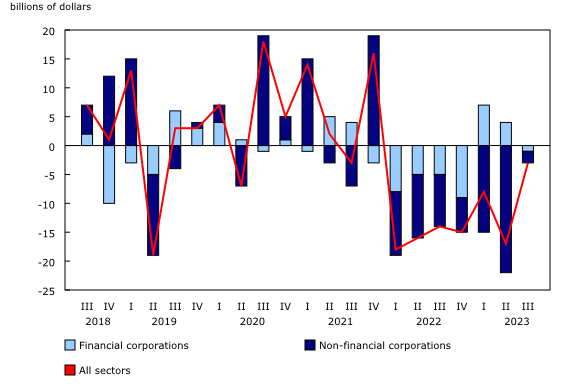Securities statistics, third quarter 2023
Released: 2023-12-07
Canadian governments and corporations borrowed a net $30.0 billion in the form of debt securities in the third quarter, down from $82.0 billion in the previous quarter. In the third quarter of 2023, gross issuances reached the highest amount since the second quarter of 2020, but they were moderated by record retirements over the quarter.
The total outstanding value of Canadian debt securities, in book value terms, reached $5,656.5 billion at the end of the third quarter, up $58.8 billion from the previous quarter. This increase reflected net borrowings as well as the upward revaluation of the stock resulting from the depreciation of the Canadian dollar against the US dollar. Nearly one-fifth (18.8%) of the total stock of debt securities was denominated in US dollars at the end of September.
Despite an increase in book value, the total outstanding value of Canadian debt securities in market value terms was down $50.6 billion over the third quarter. Overall, higher interest rates led to a decline in market prices of these instruments. In the third quarter, Canadian long-term interest rates were up by 81 basis points, while short-term interest rates were up by 18 basis points; short-term rates remained higher than long-term rates.
Government borrowing activity slows
The government sector issued a net $12.4 billion of debt securities in the third quarter, down from $54.2 billion in the previous quarter. By type of securities, net issuances of money market instruments (+$31.3 billion) were moderated by net retirements of bonds (-$18.9 billion).
Canadian financial corporations were net borrowers of funds in the third quarter, raising $9.0 billion worth in the form of debt securities in the credit market. Issuances by Canadian chartered banks totalled $19.0 billion, mainly composed of foreign currency instruments issued abroad. This activity was moderated by retirements of debt securities of insurance corporations and pension funds.
Net issuances of debt securities by Canadian non-financial corporations amounted to $8.6 billion in the third quarter. On an industry basis, the information and cultural industry (+$5.0 billion) and the utilities industry (+$3.2 billion) contributed the most to the activity.
Retirements of Canadian shares exceed new issuances for a seventh consecutive quarter
Net retirements of Canadian equity securities totalled $2.9 billion in the third quarter of 2023, the seventh consecutive quarter in which retirements exceeded new issuances. Non-financial corporations were the main contributor to net retirement activity, led by their share buyback activities. Overall, the market value of outstanding Canadian equity securities was down by $123.4 billion to $3,731.9 billion at the end of the third quarter. Canadian share prices, as measured by the Standard and Poor's/Toronto Stock Exchange composite index, were down by 3.0% in the third quarter.
Did you know we have a mobile app?
Get timely access to data right at your fingertips by downloading the StatsCAN app, available for free on the App Store and on Google Play.
Note to readers
This quarterly release, available about 70 days after the reference period, includes information on debt securities issues by sector, currency, maturity, type of interest rate and market of issuance, as well as by the economic sectors issuing debt securities in relation with the sectors investing in these instruments. It also includes information on Canadian equity securities by sector and industry. Statistics on Canadian portfolio investment abroad, previously released with Canada's international investment position, are now available with this release. Canadian holdings of foreign securities by type of securities, by currency of denomination, by country of issuer of these securities, and by sector of non-resident issuer are available.
Definitions and concepts used are consistent with the recommendations of the Handbook on Securities Statistics, an internationally agreed-upon framework for classifying securities instruments. Data are accessible through an easy-to-use and flexible visualization tool. The tool includes dynamic cross-tables that allow users to look at the dataset from a variety of dimensions, as well as other visualization layers that illustrate different characteristics of the data in the form of interactive tables and charts.
Revisions
This release incorporates statistical revisions back to 2020 as part of the regular annual revision cycle of the Canadian System of Macroeconomic Accounts. Revisions essentially reflect the integration of new data sources and benchmark survey data, as well as methodological enhancements.
Definitions
Securities statistics cover issuances and holdings of negotiable financial instruments. Securities include debt instruments designed to be traded in financial markets, such as treasury bills, commercial paper and bonds, as well as equity instruments, such as listed shares.
The book value of a debt instrument reflects the value of the debt at creation, and any subsequent economic flows, such as transactions (e.g., repayment of principal), valuation changes (independent of changes in its market price) and other changes. The book value is composed of the outstanding principal amount plus any accrued interest. The market value reflects the value at which securities are acquired or disposed of in transactions between willing parties, excluding commissions, fees and taxes.
Currency valuation
The value of securities denominated in foreign currency is converted to Canadian dollars at the end of each period. When the Canadian dollar appreciates in value, the restatement of the value of these instruments in Canadian dollars lowers the recorded value. The opposite is true when the Canadian dollar depreciates.
Products
The data visualization product "Securities statistics," part of the series Statistics Canada – Data Visualization Products (71-607-X), is available online.
The document "Enhancing Canada's statistics on securities," part of Latest Developments in the Canadian Economic Accounts (13-605-X), is also available.
The Economic accounts statistics portal, accessible from the Subjects module of our website, features an up-to-date portrait of national and provincial economies and their structure.
Contact information
For more information, or to enquire about the concepts, methods or data quality of this release, contact us (toll-free 1-800-263-1136; 514-283-8300; infostats@statcan.gc.ca) or Media Relations (statcan.mediahotline-ligneinfomedias.statcan@statcan.gc.ca).
- Date modified:



